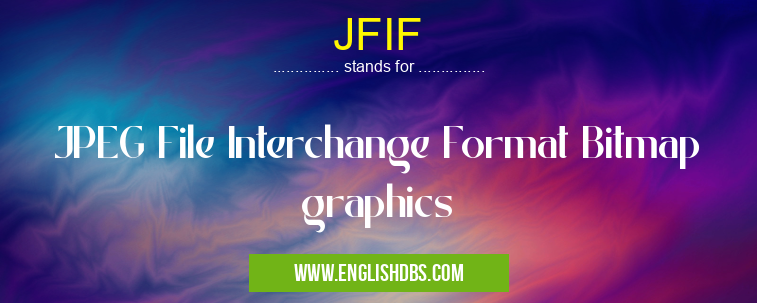What does JFIF mean in FILE EXTENSIONS
The JPEG File Interchange Format (JFIF) is a bitmap image format which is widely used to store digital photographs. It is also known as ‘JPEG' or ‘JPG' after the Joint Photographic Experts Group, who developed it in the early 1990s. The JPEG compression method used in JFIF files significantly reduces file size while still providing good image quality and data retention. This makes it an ideal format for storing and sharing digital photos over the internet.

JFIF meaning in File Extensions in Computing
JFIF mostly used in an acronym File Extensions in Category Computing that means JPEG File Interchange Format Bitmap graphics
Shorthand: JFIF,
Full Form: JPEG File Interchange Format Bitmap graphics
For more information of "JPEG File Interchange Format Bitmap graphics", see the section below.
What Is JFIF?
The JPEG File Interchange Format (JFIF) is a popular file format for storing digital images and photographs. JFIF uses a type of data compression called lossy compression, which means that some of the original picture information is lost when creating a JFIF file. Despite this, however, JFIF provides very good quality images when compared to other methods. JFIF files are typically much smaller than un-compressed image formats such as BMP or TIFF, making them well suited for storage and transfer over networks such as the internet and email systems. They are also widely supported by all major operating systems, making them an ideal choice for sharing and exchanging images between different computers or devices. In addition to its small file size and wide support, another advantage of using JFIF files is that they allow users to control how much detail they want to keep in their photos or images by adjusting their compression settings. This allows users to tailor their images according to their own needs without sacrificing too much quality or detail.
Essential Questions and Answers on JPEG File Interchange Format Bitmap graphics in "COMPUTING»FILEEXT"
What is JPEG File Interchange Format (JFIF)?
JFIF is a graphics file format often used for digital images, commonly known as JPEGs. It was designed as a standardized image-file format for exchanging pictures between computers and other digital devices. The main advantage of JFIF over other conventional formats is that it provides a higher level of compression which results in smaller file sizes and faster loading times.
What types of files can be stored as JFIF?
JFIF can store any type of image, including bitmap images, but is most commonly used to store photographs and other higher-quality images due to its advanced compression technology.
What advantages does using JFIF offer?
Using JFIF allows for much smaller file sizes than many other common image formats. This significantly reduces the amount of storage space required and significantly speeds up loading times when retrieving or sharing an image online. Additionally, since it's a standard format, it ensures compatibility across different devices or platforms.
How can I view a JFIF file?
Any software capable of viewing and editing images should be able to open and display a JFIF file. Common examples include Windows photo Viewer on Windows computers, Apple Preview on macOS systems, and web browsers like Chrome or Firefox will all typically support viewing this type of file.
Can I convert my existing files into the JFIF format?
Yes! Most modern programs have functionality specifically built in to allow users to convert their existing images into the JFIF format; this includes popular photo editors like Photoshop, GIMP, PaintShop Pro, etc., as well as some online conversion services available on the internet. In addition, some scanners may also support scanning documents directly into the JPEG/JFIIformat depending on the model you own.
Are there any drawbacks of using JPEG/JFIF format?
While there are many advantages to using this format (such as its high levels of compression), one notable drawback is that large photos often lose some detail due to the compression technology being applied to them before they are saved into the final file. Additionally, since this is a "lossy" form of compression, each time an image is saved in this format some data will be lost from it which cannot be recovered without reverting back to its original source form before saving again. For these reasons JPEG/JFIIfiles are not recommended for situations where preserving minimum levels of quality or data integrity is important - such situations would require an alternate lossless compression technique such as PNG instead.
Are there copyright considerations with using JPEG/JFIF files?
On its own no; however if you are distributing or redistributing copyrighted material then yes - you must ensure that you have first obtained permission from the copyright holder before doing so otherwise your actions may constitute infringement upon their rights under applicable laws.
Is there a limit imposed by hardware on how big an individual JPEG/JFIIfile can get?
Generally speaking no; however since larger files take longer to load onto devices there may eventually come a point where either performance issues or hardware limitations start preventing you from effectively using these larger files - so try not to get too carried away!
Final Words:
Overall, the JPEG File Interchange Format (JFIF) is an excellent choice for storing digital images due to its small file sizes, wide support across all major operating systems, and adjustable compression settings which allow users to reduce file size without sacrificing too much detail from the original picture. As such, JFIF has become one of the most popular image formats on the internet today for storing digital photography and other types of digital artwork.
